Xenobiotic, bile acid, and cholesterol transporters: function and regulation
- PMID: 20103563
- PMCID: PMC2835398
- DOI: 10.1124/pr.109.002014
Xenobiotic, bile acid, and cholesterol transporters: function and regulation
Abstract
Transporters influence the disposition of chemicals within the body by participating in absorption, distribution, and elimination. Transporters of the solute carrier family (SLC) comprise a variety of proteins, including organic cation transporters (OCT) 1 to 3, organic cation/carnitine transporters (OCTN) 1 to 3, organic anion transporters (OAT) 1 to 7, various organic anion transporting polypeptide isoforms, sodium taurocholate cotransporting polypeptide, apical sodium-dependent bile acid transporter, peptide transporters (PEPT) 1 and 2, concentrative nucleoside transporters (CNT) 1 to 3, equilibrative nucleoside transporter (ENT) 1 to 3, and multidrug and toxin extrusion transporters (MATE) 1 and 2, which mediate the uptake (except MATEs) of organic anions and cations as well as peptides and nucleosides. Efflux transporters of the ATP-binding cassette superfamily, such as ATP-binding cassette transporter A1 (ABCA1), multidrug resistance proteins (MDR) 1 and 2, bile salt export pump, multidrug resistance-associated proteins (MRP) 1 to 9, breast cancer resistance protein, and ATP-binding cassette subfamily G members 5 and 8, are responsible for the unidirectional export of endogenous and exogenous substances. Other efflux transporters [ATPase copper-transporting beta polypeptide (ATP7B) and ATPase class I type 8B member 1 (ATP8B1) as well as organic solute transporters (OST) alpha and beta] also play major roles in the transport of some endogenous chemicals across biological membranes. This review article provides a comprehensive overview of these transporters (both rodent and human) with regard to tissue distribution, subcellular localization, and substrate preferences. Because uptake and efflux transporters are expressed in multiple cell types, the roles of transporters in a variety of tissues, including the liver, kidneys, intestine, brain, heart, placenta, mammary glands, immune cells, and testes are discussed. Attention is also placed upon a variety of regulatory factors that influence transporter expression and function, including transcriptional activation and post-translational modifications as well as subcellular trafficking. Sex differences, ontogeny, and pharmacological and toxicological regulation of transporters are also addressed. Transporters are important transmembrane proteins that mediate the cellular entry and exit of a wide range of substrates throughout the body and thereby play important roles in human physiology, pharmacology, pathology, and toxicology.
Figures
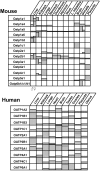
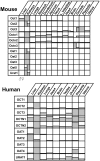
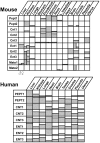
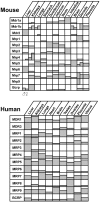
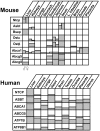
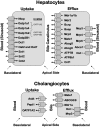


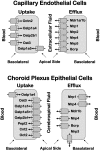

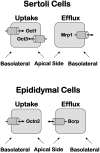
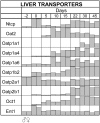


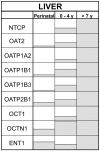
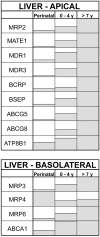

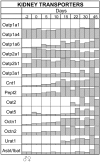



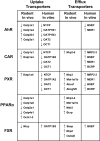

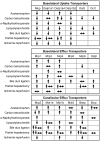
References
-
- Abe T, Kakyo M, Tokui T, Nakagomi R, Nishio T, Nakai D, Nomura H, Unno M, Suzuki M, Naitoh T, et al. (1999) Identification of a novel gene family encoding human liver-specific organic anion transporter LST-1. J Biol Chem 274:17159–17163 - PubMed
-
- Accatino L, Pizarro M, Solís N, Koenig CS, Vollrath V, Chianale J. (1996) Modulation of hepatic content and biliary excretion of P-glycoproteins in hepatocellular and obstructive cholestasis in the rat. J Hepatol 25:349–361 - PubMed
-
- Adachi H, Suzuki T, Abe M, Asano N, Mizutamari H, Tanemoto M, Nishio T, Onogawa T, Toyohara T, Kasai S, et al. (2003) Molecular characterization of human and rat organic anion transporter OATP-D. Am J Physiol Renal Physiol 285:F1188–F1197 - PubMed
-
- Adachi T, Nakagawa H, Chung I, Hagiya Y, Hoshijima K, Noguchi N, Kuo MT, Ishikawa T. (2007) Nrf2-dependent and -independent induction of ABC transporters ABCC1, ABCC2, and ABCG2 in HepG2 cells under oxidative stress. J Exp Ther Oncol 6:335–348 - PubMed
Publication types
MeSH terms
Substances
Grants and funding
- RR021940/RR/NCRR NIH HHS/United States
- R01 ES009716/ES/NIEHS NIH HHS/United States
- T32 ES007079/ES/NIEHS NIH HHS/United States
- ES013714/ES/NIEHS NIH HHS/United States
- R01 DK081461/DK/NIDDK NIH HHS/United States
- R01 ES009649/ES/NIEHS NIH HHS/United States
- P20 RR021940/RR/NCRR NIH HHS/United States
- DK081461/DK/NIDDK NIH HHS/United States
- ES007079/ES/NIEHS NIH HHS/United States
- ES009649/ES/NIEHS NIH HHS/United States
- DK080774/DK/NIDDK NIH HHS/United States
- R01 ES013714/ES/NIEHS NIH HHS/United States
- R00 DK080774/DK/NIDDK NIH HHS/United States
- ES009716/ES/NIEHS NIH HHS/United States
- K99 DK080774/DK/NIDDK NIH HHS/United States
LinkOut - more resources
Full Text Sources
Other Literature Sources
Medical
Molecular Biology Databases
Research Materials
Miscellaneous

